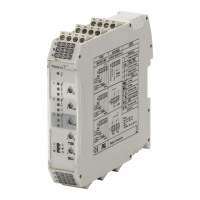PAB USER MANUAL
Photoelectric Amplifier Bus Single Series (PAB xx S)
Multiplexed photoelectric amplifier
Website: www.telcosensors.com
V 1.2 Part Number: 0666220646
E-Mail: info@telcosensors.com
This device is not to be used for Personnel Protection in Machine
Guarding Safety applications. This device does not include the self-
checking redundant circuitry necessary to allow its use in personnel
machine guarding stand-alone safety applications.
Telco A/S reserves the right to make changes without prior notice
10-30 V dc / 24V ac or 90-240 V ac
250 VAC / 3 A, 120 VAC /5 A
Approvals
Applicable Remote Sensors & Sensing Ranges
PAB 20 & PAB 30
(2 and 3 channels multiplexed)
Comments:
The range is reduced to 30 % in short range mode.
Please, refer to figure nº 1.
Green light when power is on
Green light when signal is sufficient and beam is unbroken
Yellow light when output is activated
LT/LR error
Red light for light transmitter error (disconnection or shorted)
Yellow light for light receiver error (disconnection or shorted)
Yellow and red light flashes for insufficient signal level (for
instance caused by contamination on sensors)
Please, refer to figure nº2.
1 Check the power supply complies with electrical data.
2
Make sure power is off. The amplifiers can be powered using the terminal D3 and D4 or
through the bus connector, for instance, using a PPB power supply or from another
amplifier with the terminals D 3 and D 4 already connected (powered).
3
Mount the amplifiers in the DIN rail. And connect all wires to the terminals according to
wiring diagrams.
4 Select the mode of operation. Switch power on.
Notes:
- The PNP output can optionally be supplied connecting + to terminal E4 and connecting – to
the terminals E3 on PAB 10 and F4 on PAB 20 and PAB 30.
- The amplifiers model X08 (ac version) cannot power other units through the bus.
Short / Long range
Short range
Long range
Light / Dark operated
Light operated
Dark operated
Common / Individual
(Only in PAB 20 & PAB 30)
Common output
Individual outputs
Detection (thru beam) Output mode
Dark operated
Closed On
Light operated
Open Off
Dark operated
Open Off
Light operated
Closed On
The sensitivity can be adjusted in two large steps with long/ short range selector or
continuously with the potentiometer. Maximum sensitivity and long range can be used for most
applications and is advised for applications with contaminated environments e.g. dirt, water
and dust.
Chose long range and increase the sensitivity to maximum by turning the potentiometer to full
More accurate sensitivity adjustment may be required in applications where objects to be
detected are small or translucent. Proceed with the following steps:
1
Make sure there is no object present between remote transmitter and receiver
sensors.
Select long or short range according to application.
3
Increase sensitivity slowly from minimum (full anti clockwise) until the yellow output
indicator changes. Increase a little further until the green Signal OK indicator is on.
Select target object with smallest dimensions and most translucent surface.
5
Place target object between remote transmitter and receiver sensors. If the output
changes, the sensitivity is adjusted correct. If the output do not change proceed to
6
Remove the object and decrease the sensitivity by turning the potentiometer
counter clockwise until the green Signal OK indicator is off and the LT/LR error
indicator flashes simultaneously with red and yellow light
7
Place target object between remote transmitter and receiver sensors. If the output
changes the sensitivity is adjusted to suit the target but the adjustment is very
delicate and not advisable, please contact your vendor for further information.
If the signal level is low, the LT/LR error indicator flashes simultaneously with red
and yellow light. Check the following:
Transmitter and receiver sensors are within sensing range
Sensor heads are not excessively contaminated
PAB 10 S
1 N/A
PAB 20 S
2 (Multiplexed) Yes
PAB 30 S
3 (Multiplexed) Yes
The transmitter is disabled if the test input is connected to the internal ground
(A3). Make
sure no object is present in the detection area, between remote transmitter and receiver
sensor, when test is activated. When the transmitter is disabled, a change in output will occur.
The alarm output voltage of D1 is high if the amplifier does not indicate errors and low if it
indicates an error. The indicated errors are: LT/LR error and insufficient signal level. In the
case of insufficient signal level the alarm output is flashing.
On the PAB’s amplifiers is possible to turn off its channels. This is done by turning the
sensitivity potentiometer fully anti clock wise. The channel will then be completely ignored by
the PAB.
On the 2 and 3 channels model, if one channel (on PAB 20) or two channels (on PAB 30) are
turned off, the PAB will function as a 1 channel amplifier. Consequently the PAB will be non-
multiplexed and have sensing range accordingly.
The on delay enables output signal to only activate if an object in the detection area is present
for the adjusted time period. The off delay enables output signal to remain activated for the
adjusted time period. The time delay is adjustable between 0-10 s.

